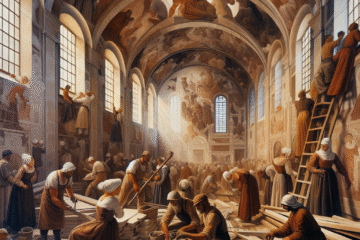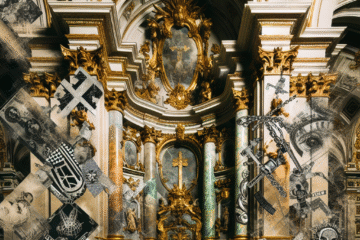I. Introduction
Light has always played a significant role in art, particularly in painting. It is a crucial element that artists use to create depth, contrast, and atmosphere in their works. In this article, we will explore the role of light in painting, its importance, and techniques for effectively using it to create stunning paintings.
Light in painting refers to the way artists represent the effect of light on objects and the atmosphere it creates. The use of light in painting can create an illusion of three-dimensionality, making objects appear to have volume and depth. It can also affect the mood and emotional impact of a painting, depending on how the artist uses it.
The importance of light in painting cannot be overstated. It is a fundamental aspect of creating a compelling and visually striking work of art. Light can be used to highlight the focal point of a painting, create a sense of space, and add drama or emotion to a scene. Without proper use of light, paintings can appear flat, dull, or uninteresting.
The purpose of this article is to provide a comprehensive understanding of the role of light in painting. We will discuss the science of light, how it works, and its different effects on painting. Additionally, we will explore the different techniques used by artists to create lighting effects in paintings, including the use of color, contrast, and shadows.
By the end of this article, readers should have a solid grasp of how light impacts painting and the different ways it can be used to create visually stunning works of art. Whether you are a beginner or a seasoned artist, understanding the importance of light in painting is essential for creating masterpieces that are both captivating and meaningful.
II. The Science of Light
Light is a fascinating and complex phenomenon that has been studied by scientists and artists for centuries. In this section, we will explore the science of light, how it works, and its effects on painting.
Light is a form of energy that travels in waves. It is part of the electromagnetic spectrum, which includes radio waves, microwaves, infrared radiation, visible light, ultraviolet radiation, X-rays, and gamma rays. Visible light is the portion of the electromagnetic spectrum that our eyes can see and is essential in painting.
Visible light can be broken down into colors that we see as a rainbow – red, orange, yellow, green, blue, indigo, and violet. These colors have different wavelengths, and they create different effects on painting.
In painting, the type of light used can significantly impact the final result. Natural light, for example, can create soft, warm tones that are perfect for creating a serene and peaceful atmosphere. On the other hand, artificial light can create sharp and vivid colors that are ideal for creating a dramatic and intense effect.
The color spectrum is a vital aspect of painting, and understanding it is essential for creating beautiful and vibrant works of art. The color spectrum refers to the range of colors that can be produced by visible light, and it is divided into three main categories: primary, secondary, and tertiary.
Primary colors are the three colors that cannot be created by mixing any other colors: red, blue, and yellow. Secondary colors are the colors created by mixing two primary colors: orange, green, and violet. Tertiary colors are the colors created by mixing a primary color with a secondary color: red-orange, yellow-green, and blue-violet.
In painting, artists can use the color spectrum to create a wide range of effects, from subtle and soft to bold and intense. By mixing different colors, artists can create new hues that add depth and complexity to their paintings.
In conclusion, understanding the science of light is essential for creating beautiful and compelling works of art. By understanding the different types of light, their effects on painting, and the color spectrum, artists can use light to create a variety of moods and emotions in their paintings. The next section will explore the role of light in painting and the different techniques used by artists to create lighting effects in their works.
III. The Role of Light in Painting
Light is a crucial aspect of painting that can significantly impact the mood and emotion of a painting. In this section, we will explore the role of light in painting and the different techniques artists use to create lighting effects in their works.
Techniques for using light in painting: One of the most effective techniques for using light in painting is creating contrast. Contrast occurs when there is a difference between light and dark areas in a painting, which can create depth and drama. Artists can achieve contrast by using different tones, values, and intensities of colors to create a dynamic and visually interesting effect.
Another technique for using light in painting is creating shadows. Shadows occur when light is blocked by an object, creating a darker area on the surface behind it. Shadows can add depth and three-dimensionality to a painting, making objects appear more realistic.
Artists can also use color temperature to create different lighting effects in their paintings. Color temperature refers to the warmth or coolness of a color, and it can be used to create different moods and emotions in a painting. Warm colors, such as red, orange, and yellow, can create a sense of warmth and energy, while cool colors, such as blue, green, and violet, can create a sense of calmness and tranquility.
The impact of light on mood and emotion in paintings: Lighting can significantly impact the mood and emotion of a painting. Bright and cheerful lighting can create a sense of happiness and optimism, while darker and more subdued lighting can create a sense of sadness or melancholy. By using different types of lighting, artists can create a range of emotions and feelings in their paintings.
For example, a bright, sunny day can create a sense of joy and happiness in a landscape painting, while a dark, shadowy interior can create a sense of mystery or suspense in a figurative painting. The mood and emotion of a painting can also be influenced by the time of day, with morning light creating a sense of energy and renewal, and evening light creating a sense of calmness and relaxation.
The different types of lighting effects in paintings: There are various lighting effects that artists can use to create different moods and emotions in their paintings. One popular technique is backlighting, which involves placing the light source behind the subject. Backlighting can create a sense of drama and depth, as well as a halo effect around the subject.
Another lighting effect is side lighting, which involves placing the light source to the side of the subject. Side lighting can create a sense of texture and depth by highlighting the contours and shadows of the subject. Top lighting, which involves placing the light source above the subject, can create a sense of drama and intensity by casting strong shadows and creating a sense of depth.
In conclusion, the role of light in painting is essential in creating a dynamic and visually striking work of art. Through different techniques such as contrast, shadows, and color temperature, artists can create a range of lighting effects that can impact the mood and emotion of their paintings. By understanding the role of light in painting, artists can create works that are both visually captivating and emotionally powerful.
IV. Famous Paintings That Use Light Effectively
Light is a critical element in painting, and many famous artists have used it to create some of the most iconic works of art in history. In this section, we will explore famous paintings that use light effectively and analyze how light is used to impact the meaning and message of the paintings.
“The Night Watch” by Rembrandt: Rembrandt’s “The Night Watch” is one of the most famous paintings in the world and a masterpiece of light and shadow. The painting features a group of Dutch militia members in the middle of the night, and Rembrandt uses light to create a sense of drama and action.
The painting is notable for its use of chiaroscuro, a technique that involves using strong contrasts between light and dark to create a sense of depth and drama. Rembrandt uses light to draw the viewer’s attention to the central figures and create a sense of motion and energy.
“The Last Supper” by Leonardo da Vinci: Leonardo da Vinci’s “The Last Supper” is another iconic painting that uses light effectively. The painting depicts Jesus and his disciples at their last supper together, and da Vinci uses light to create a sense of unity and harmony among the figures.
The painting is notable for its use of linear perspective, a technique that involves creating the illusion of depth by using converging lines. Da Vinci uses this technique to create a sense of space and depth in the painting, while also using light to highlight the central figure of Jesus and create a sense of unity among the disciples.
“The Starry Night” by Vincent van Gogh: Vincent van Gogh’s “The Starry Night” is a masterpiece of light and color that captures the beauty and mystery of the night sky. The painting features swirling, vibrant colors that evoke a sense of movement and energy, and van Gogh uses light to create a sense of depth and atmosphere.
The painting is notable for its use of impasto, a technique that involves applying thick layers of paint to create texture and depth. Van Gogh uses this technique to create a sense of movement and energy in the painting, while also using light to highlight the stars and create a sense of depth and atmosphere.
The impact of light on the meaning and message of a painting: Light can significantly impact the meaning and message of a painting, and many famous artists have used light to convey powerful emotions and ideas. For example, in “The Night Watch,” Rembrandt uses light to create a sense of drama and action, which reinforces the idea of the Dutch militia as a powerful and heroic force.
In “The Last Supper,” da Vinci uses light to create a sense of unity and harmony among the figures, which reinforces the central message of the painting – the importance of faith and brotherhood. And in “The Starry Night,” van Gogh uses light to create a sense of wonder and mystery, which reinforces the idea of the beauty and power of nature.
In conclusion, famous paintings that use light effectively demonstrate the importance of light in painting and how it can be used to create powerful and emotionally resonant works of art. By analyzing how light is used in these paintings, we can gain a deeper understanding of the impact of light on the meaning and message of a painting.
V. Tips for Painting with Light
Painting with light can be a challenging yet rewarding experience for artists of all levels. In this section, we will explore some tips and suggestions for effectively using light in paintings, creating different lighting effects, and avoiding common mistakes.
Advice on how to effectively use light in paintings: One of the most important things to remember when painting with light is to observe how light behaves in the real world. Spend time studying how light interacts with objects, and use that knowledge to create realistic lighting effects in your paintings.
When painting with light, it is also essential to pay attention to the direction and intensity of the light source. This can significantly impact the final result of the painting and can be used to create different moods and emotions.
Another important aspect of painting with light is understanding color temperature. Warm colors can create a sense of energy and excitement, while cool colors can create a sense of calmness and tranquility. By using the appropriate colors, artists can create different lighting effects and moods in their paintings.
Suggestions for creating different lighting effects in paintings: One effective way to create different lighting effects in paintings is to experiment with different techniques, such as creating contrast, shadows, and reflections. By using different techniques, artists can create a range of moods and emotions in their paintings.
Another way to create different lighting effects is to use different types of light sources. Natural light can create soft, warm tones that are ideal for creating a serene and peaceful atmosphere, while artificial light can create sharp and vivid colors that are perfect for creating a dramatic and intense effect.
Common mistakes to avoid when painting with light: One of the most common mistakes when painting with light is overusing it. It can be tempting to add too much light to a painting, but this can make it appear unrealistic and over-the-top. It is important to use light sparingly and to only add it where it is necessary to create the desired effect.
Another common mistake is using unrealistic lighting effects. While it can be tempting to create dramatic and exaggerated lighting effects, it is essential to ensure that they are realistic and believable. This will help to create a more cohesive and visually appealing painting.
In conclusion, painting with light can be a challenging but rewarding experience for artists. By following these tips and suggestions for effectively using light in paintings, creating different lighting effects, and avoiding common mistakes, artists can create visually stunning works of art that capture the beauty and power of light.
VI. Conclusion
In conclusion, light plays a crucial role in painting and is essential in creating dynamic and visually striking works of art. By understanding the science of light and different techniques for using it effectively, artists can create a range of lighting effects that can impact the mood and emotion of their paintings.
Light can be used to create contrast, shadows, and reflections, and can also be used to highlight the central figure or focal point of a painting. The impact of light on the meaning and message of a painting should not be underestimated, and many famous artists have used light to convey powerful emotions and ideas in their works.
It is essential to observe how light behaves in the real world and to use that knowledge to create realistic lighting effects in paintings. Understanding color temperature and the direction and intensity of the light source can also significantly impact the final result of the painting.
In creating great paintings, the role of light cannot be overstated. It can be used to create a sense of drama, energy, or tranquility, depending on the mood and emotion that the artist wants to convey. Through experimentation and the use of different techniques and light sources, artists can create a range of lighting effects that are unique to their style and vision.
In conclusion, the importance of light in painting cannot be overstated. It is a fundamental aspect of creating a visually compelling and emotionally resonant work of art. Encouragement is given to artists to continue experimenting with light in painting and to use it as a powerful tool for creating masterpieces that are both captivating and meaningful.


